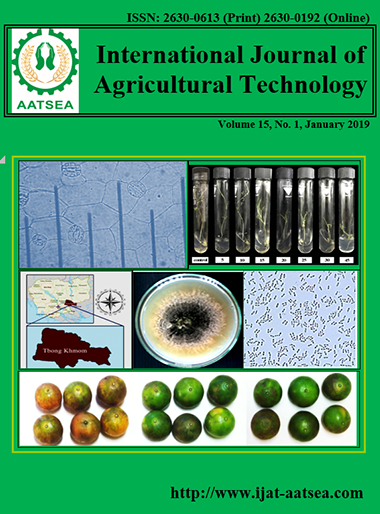Effect of seedlings numbers per hill on the growth and yield of Kum Bangpra RiceVariety (Oryza sativa L.)
Main Article Content
Abstract
The influence of seedlings number per hill on the growth and yield of rice (Oryza sativa L.) Kum Bangpra rice variety was examined at the Plant Science Research Plots in Chonburi province, Thailand, during November 2016 to March 2017. The different treatments of transplanting were performed with the number of 1, 2, and 3 seedlings per hill and 30 x 30 cm spacing. Results revealed that transplanting with 3 seedlings compared with 1 and 2 seedlings per hill was significantly differed in plant height at the age of 15, 30 and 45 days after transplanting. At the age of 60 days, there was no statistical difference in plant height between transplanting with 2 and 3 seedlings per hill. The shortest plant was observed with 1 seedling per hill. In addition, at the age of 60 days, transplanting with 3 seedlings per hill produced the highest numbers of 21.33 tillers per hill, while 1 seedling per hill produced the lowest number of 12.28 tillers per hill, suggesting the highest tillering capacity of this variety at a ratio of 1:12 when transplanting with 1 seedling per hill. Yield components including number of panicles per hill, panicle length, number of filled grain per panicle, 100-grain weight, and width and length of un-husked grains showed no statistical difference. The filled grain weight per hill indicated that transplanting with 3 seedlings per hill produced maximum weight of 39.55 gm. per hill, while 1 seedling per hill produced minimum weight of 27.90 gm. per hill. As a result, highly statistically significant difference was observed in yield/Rai at 15% moisture; the highest yield per Rai was 703 kg with 3 seedlings per hill, and the lowest one was 496 kg with 1 seedling per hill. The current experiment therefore suggested that Kum Bangpra rice variety transplanted with 3 seedlings per hill was the most suitable to produce the highest yield.
Article Details

This work is licensed under a Creative Commons Attribution-NonCommercial-NoDerivatives 4.0 International License.
References
Adams, M. W. and Grafius, J. E. (1971). Yield Component Compensation—Alternative Interpretations 1. Crop science. 11:33-35.
Chang, T. T. and De Datta, S. K. (1975). Agronomic traits needed in upland rice varieties. major research in upland rice. Los Banos, Philippines. pp. 85.
Chongkid, B. (2014). Rice and Technology.2 nd.ed. Thammasat University, Bangkok. pp.184.
Department of Rice Thailand (2006). Rice breeding and Improvement. Ministry of Agriculture and Cooperatives. Bangkok, Thailand. pp. 74.
Guo, H., Ling, W., Wang, Q., Liu, C., Hu, Y., Xia, M. and Xia, X. (2007). Effect of anthocyanin-rich extract from black rice (Oryza sativa L. indica) on hyperlipidemia and insulin resistance in fructose-fed rats. Plant Foods for Human Nutrition. 62:1-6.
Gupta, V., Ghosh, G. and Singh, S. (2010). Effect of age and number of seedlings per hill on the growth and yield of rice (Oryza sativa L.) cv. Pusa Basmati. pp. 88-90.
Javaid, T., Awan, L. U., Baloch, M. S., Nadim, M. A., Khan, E. A., Khakwani, A. A. and Abuzar, M. R. (2012). Effect of planting methods on the growth and yield of coarse rice. The Journal of Animal and Plant Sciences. 22:358-362.
Promsomboon, P. (2004). Crop Physiology. Department of Plant Science, Faculty of Agriculture at Bangpra. Rajamangala Institute of Technology, Chonburi, Thailand. pp. 267.
Promsomboon, P. and Promsomboon, S. (2016). Collection and Evaluation of Local Thai Rice Varieties (Oryza sativa L.) Journal of Life Sciences. 10:255-264.
Rana, M., Manum, A. A., Zahan, A., Ahmed, N. and Mridha, A. J. (2014). Effect of planting methods on the yield and yield attributes of short duration aman rice. American Journal of Plant Science. 5:251-255.
Sarutayophat, T., Kanha, N. and Bunchay, N. (2016). Effect of age and number of seedlings per hill on yield of japanica rice (Oryza sativa L.) cv. DOA1 planting in Central Thailand.King Mongkut’s Institute of Technology Ladkrabang. King Mongkut’s Agricultural Journal. 3:1-8.
Yoshida, S. (1981). Fundamentals of Rice Crop Science. Int. Rice Res. Inst., Los Banos, Laguna, Philippines.


